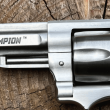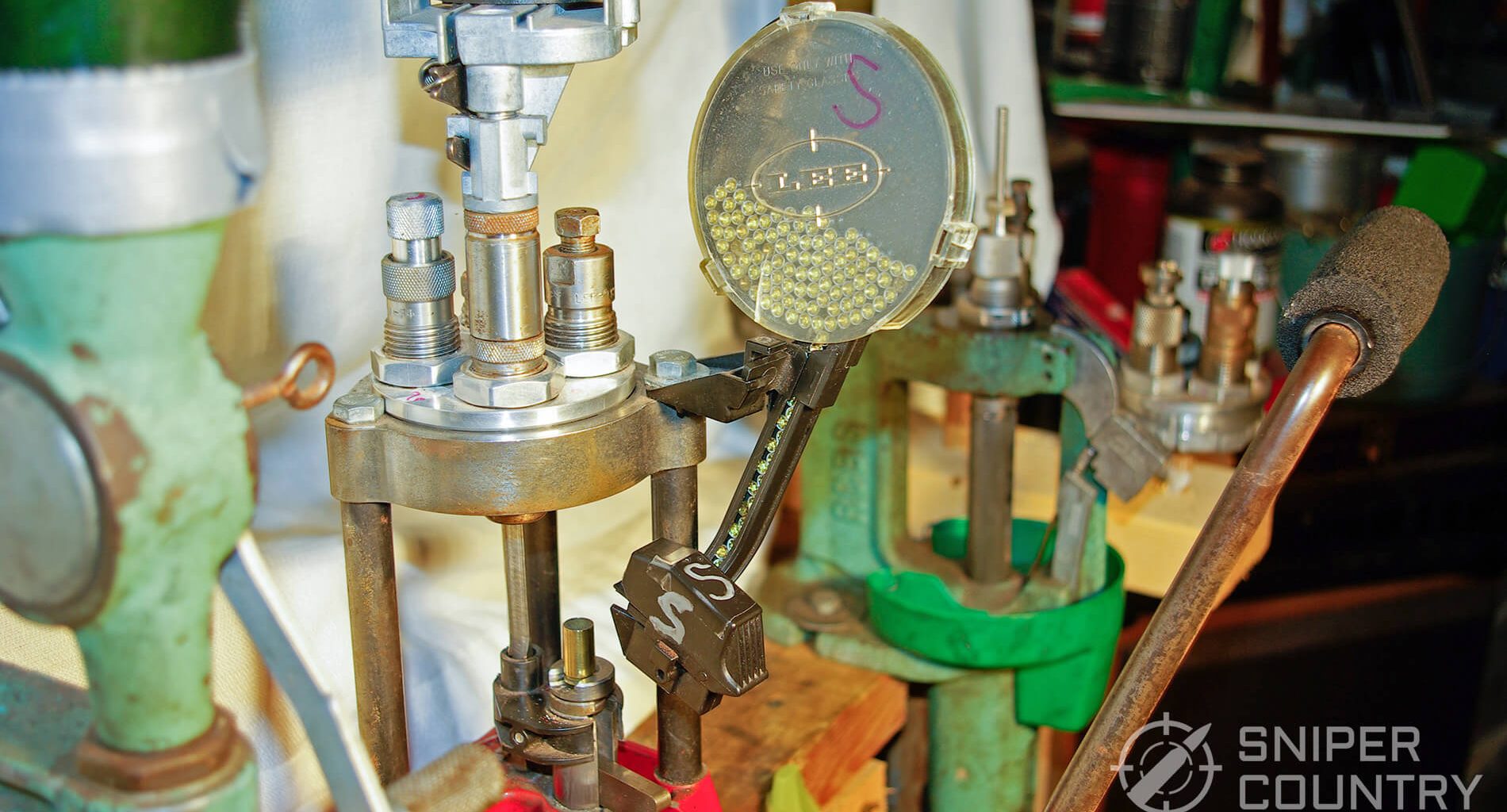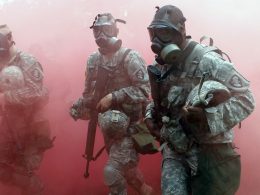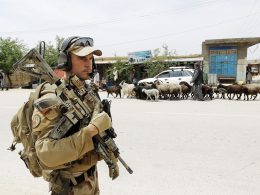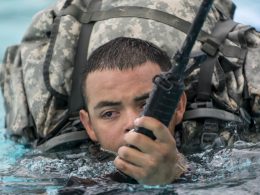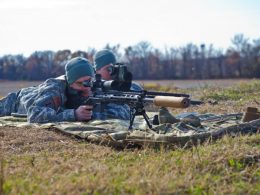In this Article:
Reloading your own ammo is a relaxing, rewarding hobby. Not only can you save money when you make your own ammo as opposed to buying factory stuff, it’s a lot of fun as well. To be totally honest, you may not save a lot of money shooting your ammo but you will get more shots per dollar than if you were using factory rounds. This depends, of course, on what caliber you’re loading. Some of the more exotic rifle calibers can cost a lot whether you’re making your own or buying theirs. Even so, it will still be cheaper per shot over store-bought ammo to varying degrees. Handgun calibers such as 9mm are where the big savings can come in if you use cast or bulk jacketed bullets. No matter what caliber or gun you’re loading for, all reloaders have one thing in common – the most basic piece of equipment that we all need is a reloading press.
What Is A Reloading Press?
If you are familiar with certain industrial processes or with making wine from grapes, they both have one thing in common … they will use a press of some type. This is a piece of equipment that basically forces Part A through or into Part B in order to make it conform to specifications. A screw-type wine press is easy to envision…load grapes in the bin and turn the cover’s handle to tighten it against the grapes and you squeeze juice from the grapes.
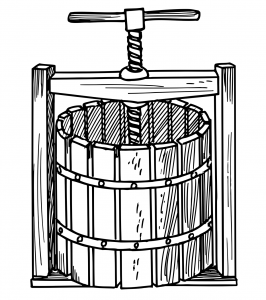
What does that have to with a reloading press? It’s the same concept. You are forcing Part A (an empty cartridge case) into Part B (a reloading die of some sort) in order to make it conform to what it needs to be in order to be ready for shooting. A reloading press is at the heart of any reloader’s setup. We will look at different types of presses, but first…
BONUS OFFER: Get your free shooting range targets to print at home!
Get your free targets to print at home!
A Little Personal Background – My Reloading Journey
So, you want to get into reloading? So did I, about 40 years ago. I think a good way to begin this reloading press article is to look back on my reloading journey, as I followed the same path that a lot of you are starting on (or are already well on your way) in the world of reloading metallic cartridges. Maybe some of my experiences will be of benefit to you.
I am a self-avowed, 40-years-experienced, reloader-for-life. Those who know me get that. My shooting friends are used to me dragging them out to my garage when we’re finished shooting at my backyard range, past all the “normal†stuff like chop saws and Cub Cadet mower over to my reloading bench, my little oasis in the desert of my cluttered garage (scroll down to see my current setup).
I started reloading in 1978 after buying a Ruger Blackhawk .45 Colt with a 7.5-inch barrel. Factory ammo, even then, was expensive for this fresh-out-of-college music teacher. So, I got a Classic Lee Loader that consisted of, among other things, a die that resized the case by your whacking the case into it with a mallet. (Hopefully, lubrication came first). It was ingenious, really… you had a spring-loaded platform on which to place the case for priming and case-mouth-expansion and bullet-seating dies. Some guys bought those loaders to take to the range with them so as to be able to customize loads at the shooting bench. I had one because it was what I could afford, and it worked fine – it was just s-l-o-w.
I used that little guy a lot, until I could afford something that you actually bolted to a workbench. Long about a year later, I got an RCBS Jr. single-stage press, a Uniflow powder measure and an RCBS 5-0-5 powder scale with related accessories. I also got an RCBS case trimmer.
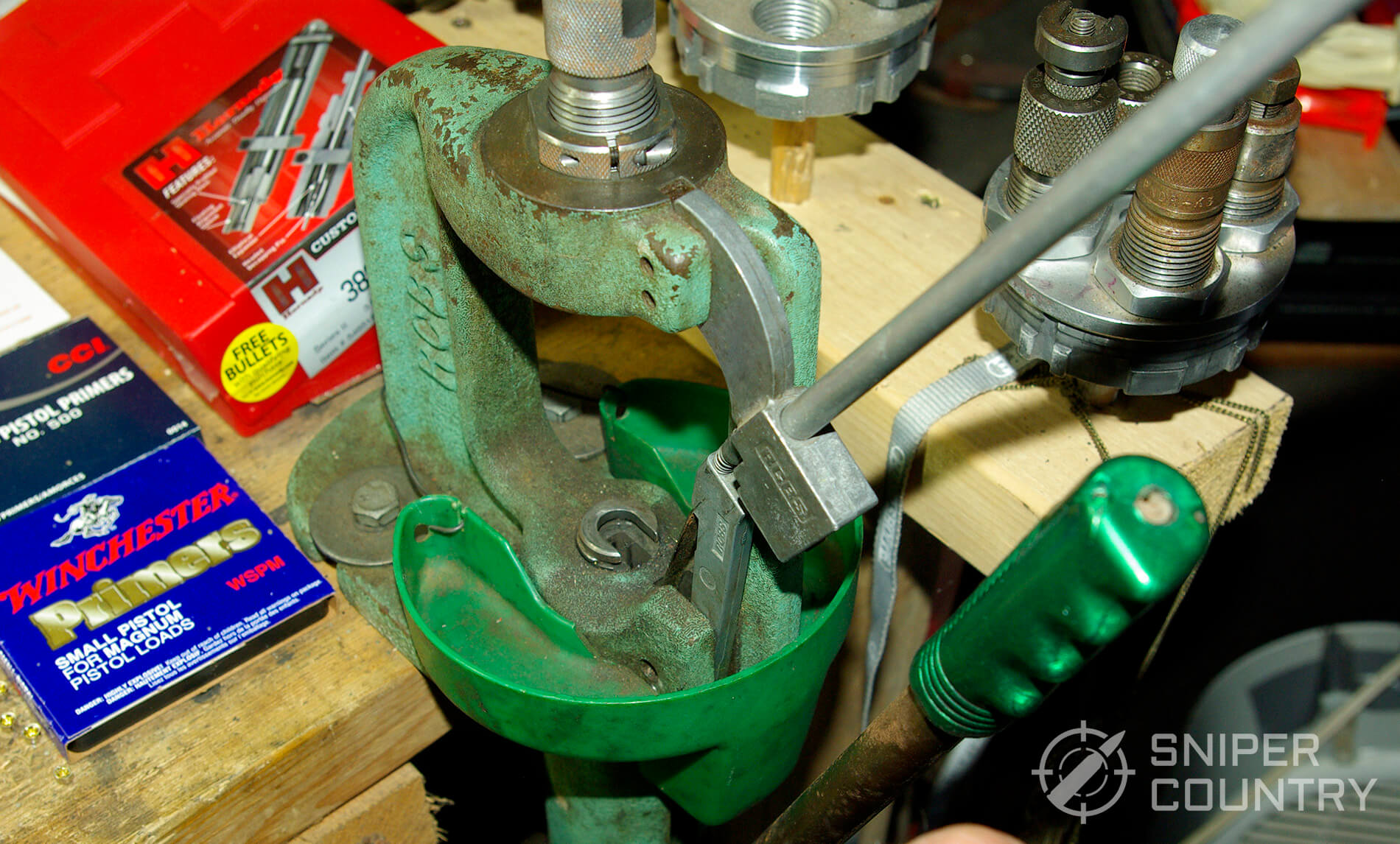
I thought I was in reloading heaven. I could now crank out many more rounds per hour than I could using the “whack-a-mole†setup. I had to have a .44 Magnum, of course – any shooter worth his or her salt back then had to have one, it WAS 1979 after all – so I traded the .45 Colt on one. I remember, before I got into bullet casting a year or so later, buying several 500-count boxes of Elmer Keith’s famous 245-grain Lyman 429421 hard-cast semi-wadcutter with the long nose, wide driving band and deep grease groove.
I suppose you could probably build a full-size replica of an Edsel Citation out of the lead I’ve put into shooting backstops over the past 40 years, and that Keith bullet started it all off. I have memories of going to a silhouette competition with that .44. Long story short, I used my RCBS press to put some loads together that Elmer himself supposedly used. (Those fellow grizzled long-time-revolver-reloaders out there will know which load I’m talking about…THE load…). My RCBS Jr. press was more than up to the task, even without its more-expensive fellow RCBS press’ compound leverage, the Rockchucker. These loads were, to put it simply, little bombs that went off with each trigger pull. It got so bad that I had a bone raise up in my wrist that you could see. No pain, but not good. So, I backed off and to this day load mostly mid-range loads. My wrist is happier.
My Current Setup
Fast forward a few years when I got the itch to get a faster press, so I got a Lee turret press. (I will explain in detail the differences between the two types below).
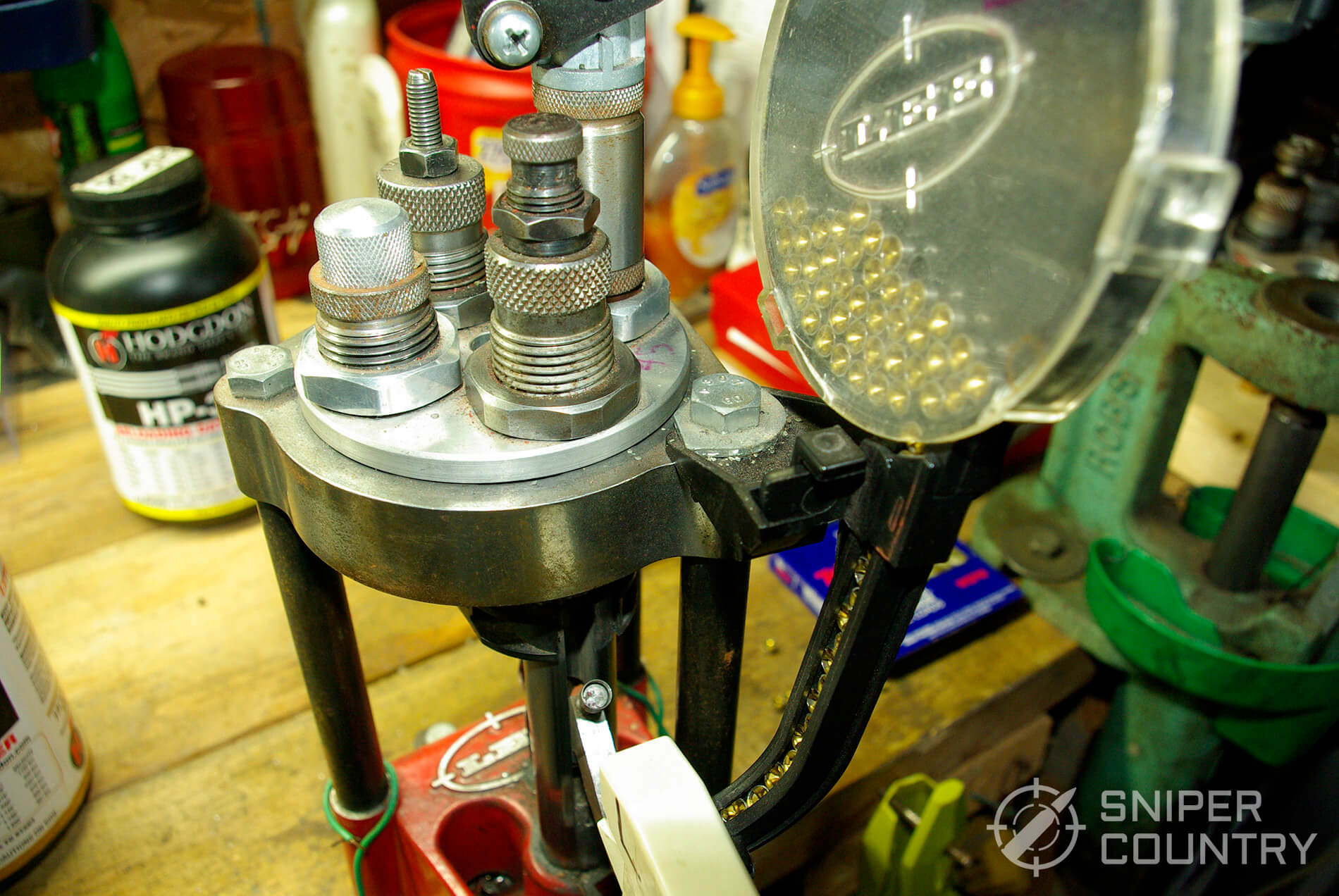
Now I was in business! I could conceivably crank out 200-300 rounds per hour, if I held my mouth just right. This press was what enabled me to get into volume shooting, especially with the 9mm and .45 ACP calibers.
My current setup is one press sitting next to the other one. Each has its uses. I use both of them regularly.
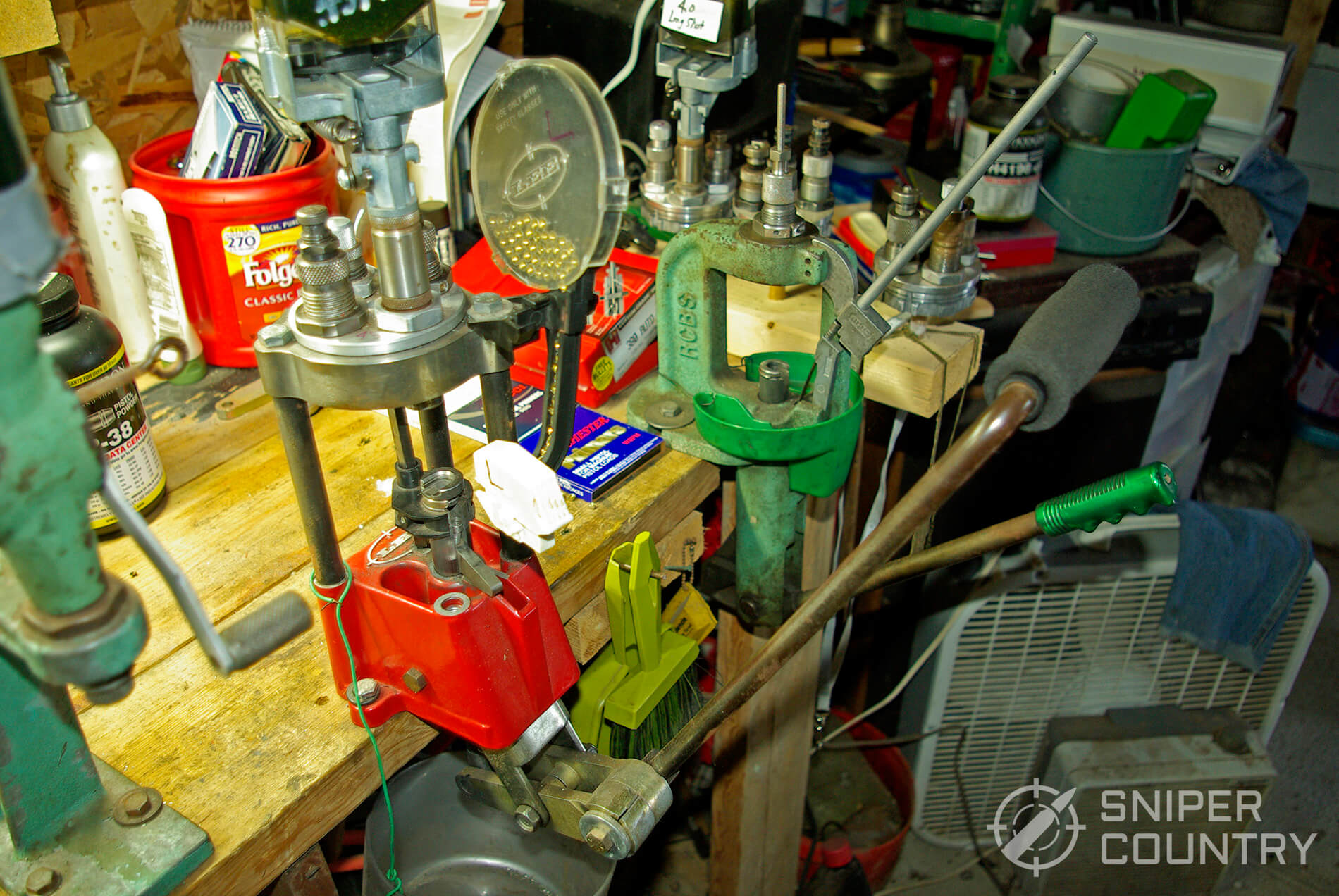
They have both held up for many thousands of reloaded rounds. Notice that they do not appear new – the paint is chipped, there’s rust here and there and they look, well, used heavily. That’s because they are. These two items have been the best investment I’ve made for my shooting hobby, excluding guns. They are quality machines that will last a lot longer. As long as you keep the press ram (the part that holds the shellholder on a single-stage press and goes up and down), the handle connections lubed and just generally take care of it, a press should last close to forever. I DO clean off rust and crud every now and then. The important parts all work as designed. These machines are like old friends to me…I remember when I first got each one and the ammo I produced then. It’s a great feeling shooting steel, putting holes in paper targets, going to competitions or taking a deer with bullets you’ve cast and loaded with your press.
What Exactly Is Reloading?
Now that we’ve explored my ancient history, let’s talk a bit about different types of presses. Before you continue reading, you need to know the process of reloading. I wrote a rather lengthy article on that, so I will put in a shameless plug here for that piece. Without me taking up a lot of space re-explaining the process, please go here. It will help you to understand just what functions reloading presses perform. After we look at the different types of presses, I’ll make some recommendations as to specific presses that are good buys. Here’s a point to consider – if you are new to reloading, you may consider buying a press kit. A kit has most everything you need to get started in reloading as opposed to buying just a press by itself.
Most of the presses we’ll look at also come in kit form at extra cost but it saves you having to track down all that extra equipment. If you are a seasoned veteran reloader, chances are you’ll already have the things that come with a reloading kit but bear in mind that if you change brands or types of presses, different accessories for your new press will most likely be required and your old gear may not work. This is especially true for press-mounted powder measures, case feeders, etc. If you use a separate powder measure and other components, then you should be good to go.
Reloading Presses 101
I’ve mentioned both single stage and turret presses…what are they, and are there any other types out there? Basically, there are three different types of reloading presses:
Single Stage, a press that performs one function at a time; for example, all cases are resized at once, then the die is changed and all cases go through that process, etc.
Turret, a press that has a die plate with three or more die stations and will produce a loaded round with a few pulls of the operating handle;
Progressive, a multi-station press that, once every shellholder on the toolhead is occupied, will produce a loaded round with each handle pull. This is the most automated press of the three types and can be a bit tricky to set up or to change calibers but will crank out ammo at a prodigious rate.
Let’s look at each type.
Single Stage Presses
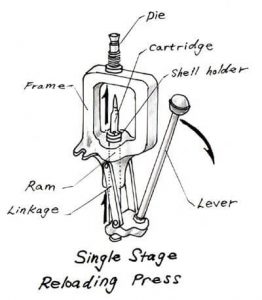
This press performs one function at a time. It has a place to screw in only one die. You will take all your clean, prepared cases for one caliber and run them all through the resizing/decapping die. Next, you will expand the case mouth (handgun cases) and prime them. After charging the cases with powder, you will seat the bullet with the seating die. If it’s a semiauto pistol round, you should screw in the proper factory taper crimp die and run the loaded rounds into that. That’s the process in a nutshell. (If you passed on the opportunity above to read about the reloading process in detail, you may want to re-think that and check out the other article. It can be a bit daunting for a person just getting into reloading to understand the process. Just a suggestion).
PROS:
The single-stage press has several advantages. They include:
- Strength. The single stage press, especially if an “O†design like the one in the photo above, is one strong piece of equipment. I have used mine to full-length-resize large rifle cases, something I wouldn’t want to try on my other press.
- Versatility. I use my RCBS press to not only load ammo, but (with the right die) also use it to size bullets. Lee makes a push-through bullet sizer set that works well with the single stage press.
- Cost. You can buy a new entry-level single stage press for less money than a turret or progressive press..
- Ease of Use. Multi-die presses can be tricky to set up and maintain. If something goes wrong, your production is stopped until you fix it. With a single stage press, there is no complicated mechanism to get fouled up. In this case, simple is good. I always recommend that beginners start with a single stage press then work up to a multi-station one.
- Priming. Most single stage presses have some sort of provision for priming on the press. Whether you are a fan of this system or would rather prime off the press, most of the presses are set up to do this.
CONS:
- Speed of Production. You sacrifice speed when using a single stage press. Where a turret or progressive press will produce a loaded round with one or more pulls of the press handle, the single stage press cannot do that.Your round-per-hour total will not be as great unless you are very experienced using the press and at swapping out dies. It also helps to have powder, primers and bullets all set up and ready to go in order to speed up production on a single stage press.
- Lack of Ancillary Functions. On a turret or progressive press, you may have the option of mounting a powder measure, bullet feeder or case feeder. The single stage press does not allow those, at least on the ones I’ve seen. You must use a separate powder measure and feed cases and bullets by hand.
Turret Presses
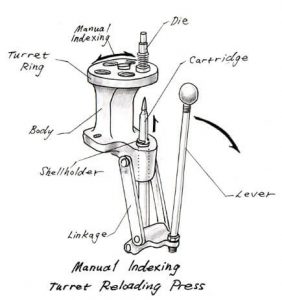
Turret presses have one shellholder on the ram and a die plate with three or more threaded holes that accept standard reloading dies. The red press in the photo above is a four-station example, a Lee Turret Press. There is a station for one of each of the following dies: (1) resizing/decapping, (2) case mouth expansion/powder charging, (3) bullet seating and (4) factory taper crimp. (I reload mostly handgun cartridges, so there are two dies shown that most taper-shoulder rifle cartridges will not use – the case mouth expander and the taper crimp dies).
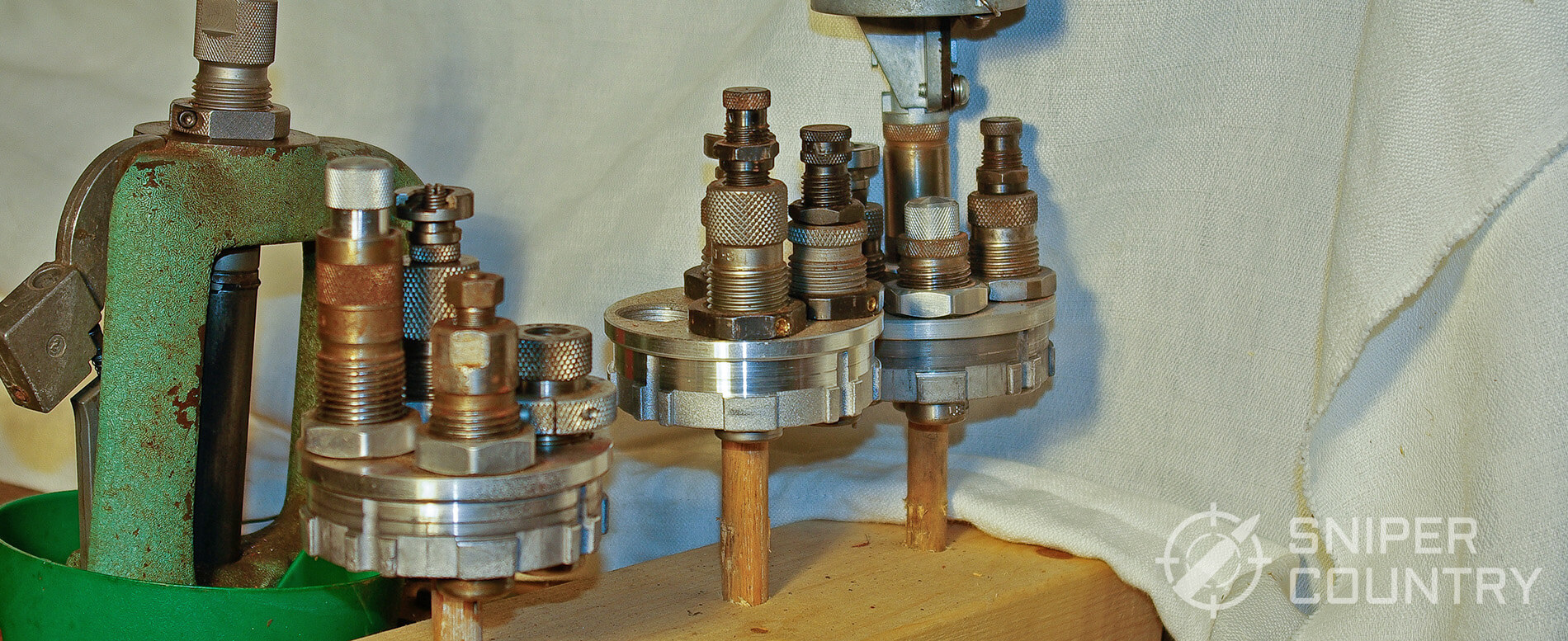
The advantage of having all the dies in the set mounted is speed – you can really move cases through the process quickly with practice. Considering that functions such as powder metering and dispensing can be performed with this type of press, speed is increased. Please remember that turret presses are not progressive…it still takes several pulls of the handle to produce a loaded round. One way to think of turret presses is that they are like single stage presses except that you can mount all the dies and powder measure at once. Just as you must pull a single stage press handle for each operation, so must you pull the turret press handle for each step. It’s just that, with each handle pull, the die plate rotates to the next station which saves time over having to screw in each individual die. Add in the powder being dropped from a mounted powder measure through a special hollow case mouth expansion die and you start to get the picture. Production can be greatly increased over that of the single stage press.
PROS:
- Speed of Production. As stated above, with the rotating die plate and powder-through die, you can load many rounds per hour. I have loaded anywhere from 200 – 350 or so rounds per hour with my inexpensive Lee Turret Press.
- Consistent Operation. Once set up, a die plate can be stored with all dies adjusted and a powder measure attached. All you do is remove the one on the press and replace it with the new one and you’re good to go. There is no readjusting needed usually.
- Ancillary Functions Possible. As mentioned, you can dispense powder on the press itself. Priming is easily accomplished, as well.
- Cost. Most turret presses do not cost as much as a true progressive press and are available in kits with everything you need to get started. The money you save can purchase powder, primers and bullets.
CONS:
- Moderately-Difficult Setup. The turret press is not as easy to get into action as is the single Stage. There is a fair amount of adjusting needed before any loaded rounds are produced.
- Maintenance. There is more to break or go out of adjustment with the turret press than is present with the single stage. I find myself swapping some parts out (like the rod that allows the die plate to rotate) as they wear, but this is to be expected with the functions that are performed.
- Strength Issues. As I said, I won’t try full-size rifle case sizing on my Lee turret press; it is not designed to do that. Neck sizing, sure. There are some turret presses out there that are strong enough for these tasks but I like my single-stage press for heavy-duty work.
Progressive Presses
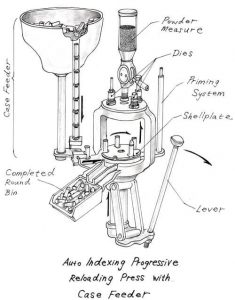
A true progressive press will, once all the die stations are filled, produce a loaded round with each pull of the operating handle.This is what sets this type of press apart from a turret press. These presses are used mostly for handgun ammo but there are some uses for them with rifle cartridges such as the .223. The progressive press has a toolhead (rotating shell holder plate), not a rotating die plate as the turrets use. You put a case in the first station, pull the handle and rotate the plate so that case 1 is in station 2. You put another case in the first station, pull the handle and rotate the plate and both cases have advanced. All the familiar (handgun) reloading stages – resizing/decapping, case mouth expansion, powder charging, bullet seating/crimping – is performed except that a loaded round drops out after every handle pull when all stations are loaded. Many individuals who compete in shooting sports and gun clubs will use progressive presses due to the volume of ammo needed. They are very good at cranking out 500 rounds per hour under the right conditions.
PROS:
- Speed and Quantity of Production. As I just said, you can load several hundred rounds per hour with this type of press.
- Adjustment-Free After Setup. By this I mean that, once set, a progressive press will not change settings unless you want them changed. Most people who load for more than one caliber on a progressive press won’t bother changing out the dies and readjusting everything – they simply buy a different press for each caliber. Once set, it’s set and it’s easier to add a new press than to change things.
- Uniform Quality. Most progressive presses produce very consistent ammo. There are features that are optional that will, for example, tell you if a case was skipped when powder was dropped. All operations tend to be very repeatable and consistent, and with error-checking options in place, it’s unusual to have a bad round come through.
- Lots of Options. When you look at, say, a Dillon print ad that shows one of their excellent progressive presses, you will invariably see several disclaimers in tiny print that says in effect that optional equipment is shown. Some of the upgrades include, but are not limited to, case and bullet feed tubes, powder checking, bullet drop boxes, etc. With a progressive press, you literally have a one-person ammo production line.
CONS:
- Cost. Even though an entry-level bare-bones progressive press can be purchased for under $300, if you add on the “goodies†that most buyers purchase, you could easily spend at least $600 or more on your setup. Contrast that to an entry-level turret press around $200. I know, they do different things, but that’s a pretty big difference.
- Complex Setup. These are precision instruments that perform a plethora of tasks that require close tolerances. If you want the production available to you with these presses, it will take some time to set it up to do what you need it to do. There are plenty of help videos online that will guide you.
- Larger Footprint. These are not small machines. A typical progressive, outfitted with options that help speed production, can require the work space of two smaller single stage or turret presses. As I said before, you’re a one-person ammo production line and it will take some room to facilitate that. Remember that there are, probably, extra pieces attached to help speed production and that these will require some extra elbow room. Plus, you’ll need a place to store the ammo as it comes off the press. The progressive press will pile up ammo at a faster rate than the other two types, so be ready.
- More Moving Parts. The maintenance factor with progressive presses can be higher than that of the other two types in no small part due to what makes it so desirable – its complexity is what allows it to produce hundreds of rounds per hour. Counting adjustments, the time spent working on the press as opposed to working with it can be considerable, especially up front as you set it up.
- Lots Of Options. I know, I listed this as a Pro, but some presses will work to full capacity only if you’ve installed several (sometimes expensive) optional pieces of equipment.
Recommendations
OK…so you know you want a reloading press or press kit and you have a budget set for its purchase. What now? I’ll list a few press kits at different price points. (If you want just the press, those are available as well. I’m just showing what’s out there to get set up and going quickly).
Disclaimer, Of Sorts…
Before I get specific, let me state that there are many really good presses out there and that it’s very hard to narrow it down to just a few. You may have a Brand X press that you love and it’s lasted for years that I don’t mention. That will probably happen with many of you. Just because I don’t list your favorite doesn’t mean anything… I just had to draw the line somewhere. So now, here are some products to look at…
Single Stage Press
Budget
Look at Lee equipment. You can buy a kit that is well-made and gives you just about everything you need to get into reloading for one caliber for well under $300.
Advanced Reloader
The world opens up if you are able to spend a little more. Some other reputable companies that make Presses include Hornady, RCBC, Lyman, Redding and others. We’ll look at some of the more popular and available presses and kits for the advanced single-stage reloader.
Here’s a Hornady kit that includes what you need to get started… the Hornady® Lock-N-Load® Classicâ„¢ Kit
This kit includes the Hornady reloading manual, one accessory that is required for ALL reloaders! Everybody needs at least one manual put out by a reputable manufacturer. Internet information about loads (unless it comes from a manufacturer’s website) can be sketchy at best. Hornady makes top-quality equipment.
Turret Press Kits
Budget
Again, I recommend Lee. I have one that has lasted well over 30 years with only about 4 parts that needed replacing. Most Lee turret presses are auto-advancing, so the plate turns as you work the handle. Coupled with the ability to drop measured powder charges and priming from the press is the production increase that a turret press offers.
Here you have everything you need to get going except for the dies. Included are accessories that handle powder weighing and handling, priming and case prep. You also get Richard Lee’s excellent tome on reloading – that’s a nice touch. For the money, Lee is hard to beat. They also have responsive customer service (as do most all press makers) — that’s important. A four-station turret plate allows all four handgun dies (resizing/decapping, mouth expansion/powder drop, bullet seating and factory crimp) to be installed. To change calibers, just twist the plate up and off the press and insert a new one. This is an easy press on which to learn the basics of multi-stage reloading.
Advanced Reloader
Here’s a bit of a surprise, at least for me. Lyman made its reputation by making top-quality bullet casting equipment and is generally not known for reloading presses. Don’t get me wrong – they’ve made this type of equipment for years. Their latest efforts are getting more notice than perhaps they did in years gone by. This kit includes a six (not four or five) station die plate, a digital powder scale (finally!!), a case prep multi-tool and the well-known Lyman Reloading Handbook #49 that both my son and I have. It even includes a loading block to hold your cases during loading. For under $500, you get one of the toughest-built presses out there and a bunch of extras. That’s hard to beat.
Progressive Presses
Now we’ll look at the progressives. All press companies that I’ve explored make at least one
Progressive press. As stated in my Disclaimer above, I have to narrow it down to just a couple of presses but there are several that would be good buys. I’ll list a lesser-expensive one and then a higher-end press, as above. One important difference with progressive presses is that they are usually already set up for one caliber and to change that requires extra expense and time. That is why many volume shooters will have three or four presses set up, one for each caliber they load.
Budget
I have mentioned a Lee press for each of the Budget categories. In case you can’t tell, I like Lee equipment. I have bullet molds, lead furnaces, and all manner of other Lee things sitting on my reloading bench. Can you buy heavier-built presses? Sure, that’s where the Advanced category comes in. But…for the money, it’s hard to beat Richard Lee’s products. Shown here is the press and related equipment (powder measure, case feeder, etc.) bolted to their press stand. If you don’t have room for a full-blown reloading bench, this could sit in a closet until needed. My Lee turret has stood the test of time and I see no reason why this one won’t as well.
Advanced Reloader
Here is one of the most popular progressive presses going. To be sure, as I said above most of the other companies make progressive presses in addition to the others they produce. For Dillon, this is just about all they make. They make exactly one non-progressive turret press, one shotshell press and one progressive model for European export. The rest are all progressives. The 550C is #2 in their price line – they make one called the Square Deal for about $5 less – but the 550C has some pretty useful features.(For a more complete look at this press than I have room for here, look it up on Dillon’s website). Once you get everything set up and all the stations on the toolhead have a case in them, a loaded round is produced with each handle pull.
One difference between this press and some others is that this press is manually indexed. You must physically rotate the toolholder to each station. They do make auto-indexing presses but if you are wanting to get into the world of progressive presses, this might be the way to go…go at your own pace and advance when you are ready.
Each Dillon press (and some of the other brands) is set up to do one caliber – you can get quick-change optional equipment to swap between calibers – but most shooters simply set up a separate press for each caliber, as I said above. It’s faster that way, and if you shoot 1,000 rounds a week in practice and competitions, faster is good. The progressive is the end of the line for quantity ammo production – there are those machines that are capable of being electrically automated to become their own little ammo factory – so if you are looking for the absolute most ammo in the shortest amount of time, give one of these a look.
The Take-Away…
So, what did we learn about reloading presses? Hopefully, I’ve helped you if you are thinking of getting into reloading, or if you’re thinking of upgrading. I can’t emphasize too many times that there is a whole lot of good equipment out there for reloading and I’ve only specifically mentioned six presses, a drop in the reloading ocean.
Here are a few questions to ask yourself before plunking down your hard-earned money on equipment:
- What am I going to reload?
- Handgun ammo?
- Straight-walled rifle ammo?
- Rifle ammo with a shoulder?
The answer to this may help narrow your choices. For all but the toughest shouldered-case ammo, any of the three types will work, but if you are loading something that’s sized just south of the .50 BMG (there are specific loaders for this), you may want to consider a heavier-duty single-stage press. Most of the companies say their turrets and progressives will do “even a .338 Lapua Magnum…†but I’d rather not stress the machine too much. That’s why having more than one type on your bench is desirable – do your quantity stuff on your turret or progressive and your heavy-duty stuff on your single stage press.
How much should I spend? This is pretty obviously answered by looking at the different offerings that companies show and their prices. I’ve tried to include good buys for the money and I hope it helps you at least have a starting place as you begin shopping. Having said that, buy the best press you can afford…you won’t be sorry. You can get into reloading for under $100, and if that is what you have to spend, that’s OK – at least you’ll be rolling your own ammo! Nothing wrong with that. It’s like everything else…the more you spend, the easier the task becomes (for the most part, at least). It does work that way with reloading equipment.
Should I buy a progressive press since I’ll probably end up with one? Let me ask – are you new to reloading? If so, then “no.†Start with a single-stage and learn the steps and tips & tricks and then later invest in a turret press, unless you are REALLY into competitive shooting and need hundreds of rounds at a time. Then, go for it, but only after grounding yourself in the basics.
These are only a few of many questions you could ask, but they are important ones. There are many online resources that will aid you in deciding on equipment and answer other questions you may have. Check first with the press manufacturers. Most have videos that really help. Another source of answers is right here – please feel free to reply to this below with specific questions and I’ll do my best to answer them.
The point is…get going! Get your equipment and supplies and start cranking out that ammo.
Just one word of caution…I’ve had my share of less-than-stellar moments at my reloading bench, so pay attention to details! Reloading can be dangerous, please read our disclaimer regarding information we provide here.
There’s a great feeling of satisfaction that comes from shooting ammo you put together. Isn’t it time you tried it if you’ve not done it before? For you advanced reloaders, ever think about upgrading your press? I would love to do that. Anyway, have fun!

